War Clubs and Power in the Marquesas Islands
For countless generations, the traditional Marquesan war club was both a lethal weapon and a symbol of prestige. And starting in the early 19th century, it became the ultimate souvenir for merchants and missionaries who visited these remote islands in the South Pacific.
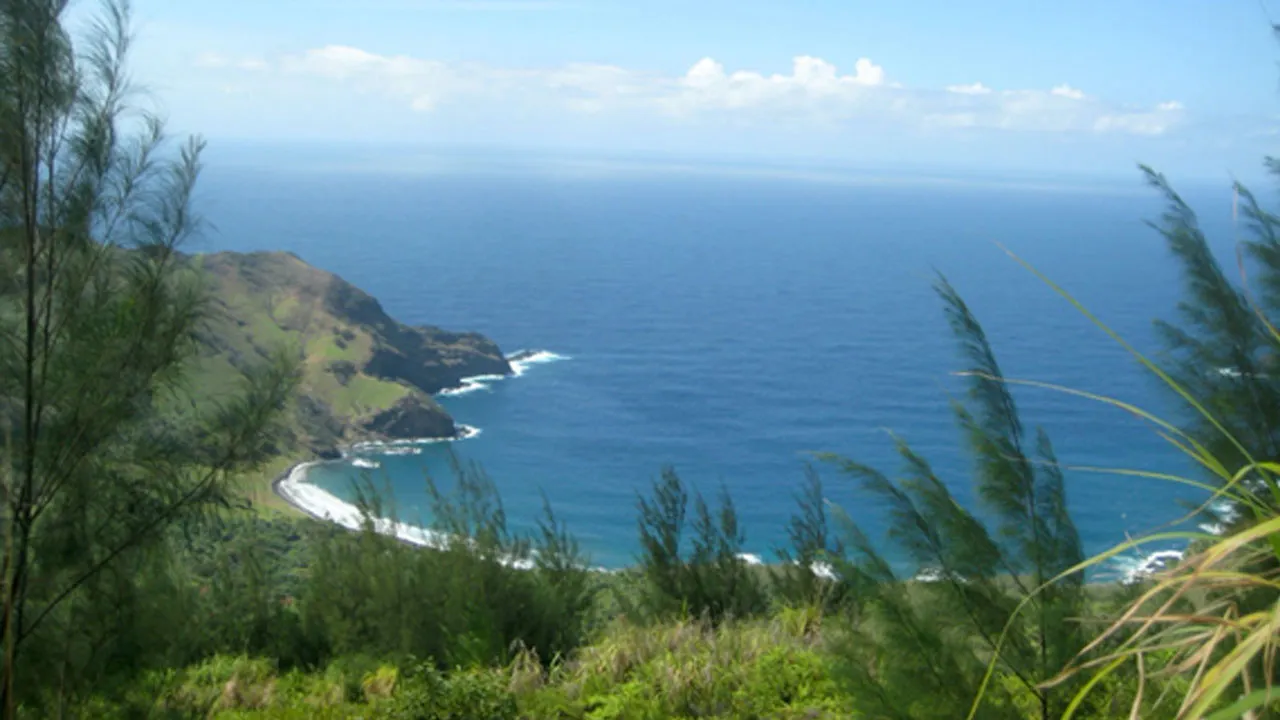
Toa trees, also known as ironwood, overlooking Hanateio, a formerly inhabited valley on the Marquesan island of Tahuata. (Image credit: Emily C. Donaldson, 2012)
Jan 17, 2022
HIGH IN THE MOUNTAINS of the Marquesas Islands, the wind blows fresh and sharp. The ocean stretches like a vast, hazy blue plain into the distance, and down below the peaked roofs and colorful boats of the villages look like tiny models of themselves. Here at the edge of the sky one often finds the toa tree, a scraggly evergreen that clings to the dark red volcanic soil.
For Marquesan warriors, the war club, or ùu, was both a lethal weapon and a symbol of prestige. ... Beginning in the 1830s, for the merchants and missionaries making stops in the Marquesas, the tattooed Marquesan warriors and their ùu held a special fascination.
Western visitors know toa as ironwood, or Casuarina equisetifolia, a heavy wood so dense it sinks in water. As it did for their ancestors, to the Marquesan artists of today toa serves as the material for making their war clubs, or ùu (pronounced “OO-oo”).
The six inhabited islands of the Marquesas are lofty green havens to a host of endemic land and sea species and a human population of just over 9,000 people. Part of the French overseas collectivity of French Polynesia, these islands sit just below the equator, about 1,000 miles northeast of the capital city of Papeete, Tahiti, and over 3,000 miles southwest of Los Angeles. Many Marquesans live from the land, cultivating fruit, fishing, and harvesting coconuts whose meat is dried and sent off for processing into oil in Tahiti.
Lethal Weapon, Prestige Symbol — and the Ultimate Souvenir
The war club brought to the ANTIQUES ROADSHOW in Middletown, Connecticut, in August 2021 (pictured beiow), is an ùu acquired by an American whaler sometime in the 19th century, a testament to one of many historic encounters between Islanders and foreign visitors. As its owner, April, recounted to appraiser Anthony Slayter-Ralph, it became a treasured heirloom passed down through generations of her family, and which Slayter-Ralph says would currently have a retail value of between $30,000 and $40,000.
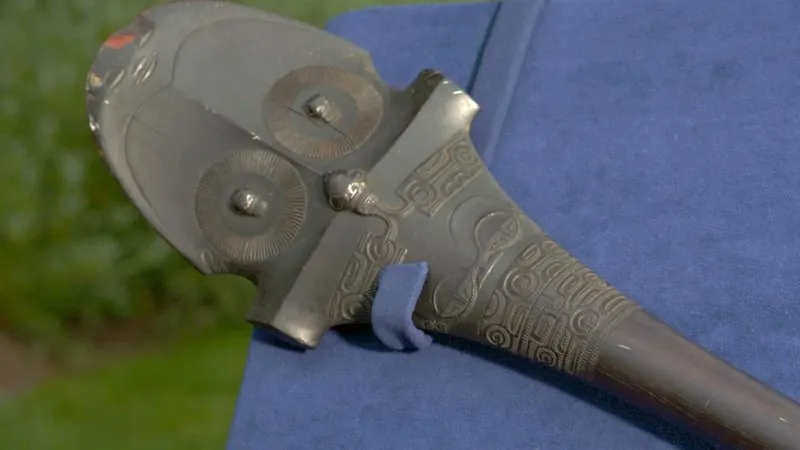
April, a guest at the August 2021 ANTIQUES ROADSHOW in Middletown, Connecticut, met with appraiser Anthony Slayter-Ralph to discuss this early 18th-century war club, or úu, from the Marquesas Islands. It has been in April's family for several generations, and Slayter-Ralph estimated its current retail value at $30,000 to $40,000.
For Marquesan warriors (also known by the term toa), the ùu war club was both a lethal weapon and a symbol of prestige. Its intricate motifs, each one painstakingly carved into the hard toa wood, represented the supernatural strength and protection of mana, the sacred power of the ancestors and gods. In Marquesan legends ùu are used to threaten, duel and knock people out, as well as to kill.
The Legend of Kae tells of a disrespectful boy imprisoned by the Tohuti clan and threatened with death. When his father, Kae, heard the news he “seized his club” and confronted the Tohuti, who “saw his eyes filled with tears and the club in his hand. Those men of Tohuti were afraid, for then they knew that this was Kae’s first born.” By bringing along his club, Kae made it clear he meant business.
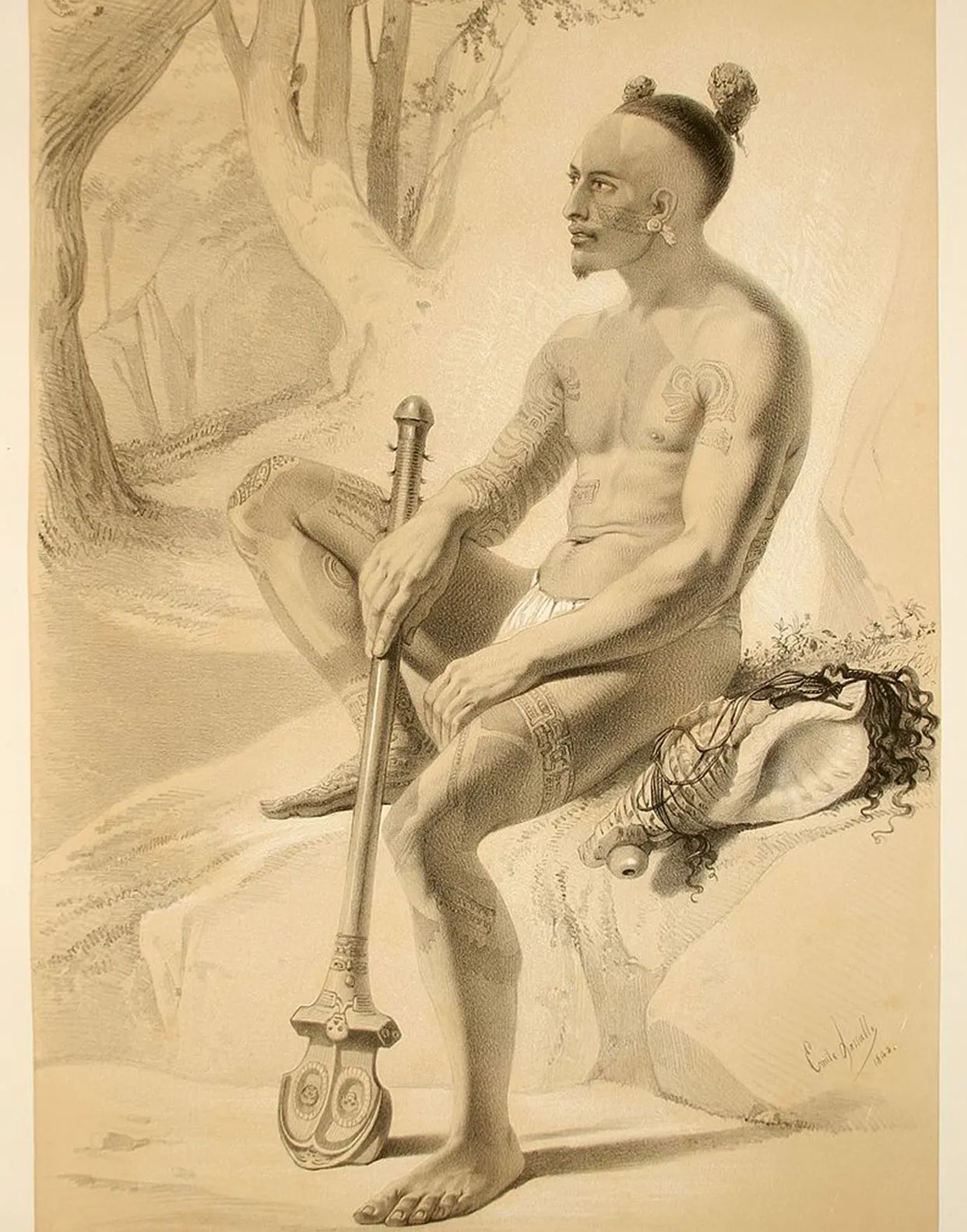
A Marquesan warrior of Nuku Hiva. Original engraving by Émile Lassalle, 1846. (Image source: Wikimedia Commons.)
In the 1830s and 40s, some 15 whaling vessels were making stops in the Marquesas each year, to say nothing of sandalwood traders, merchant and military vessels, and missionaries. For the men on these ships, the tattooed Marquesan warriors and their ùu held a special fascination. Combining fierce masculinity with the ornate and exotic, war clubs were impressive pieces of art — the ultimate souvenir.
Among the items a sailor might exchange for an ùu were Western novelties such as firearms, wine, metal tools and buttons, beads, mirrors, clay pipes, or even instruments like the Jewish harp. In many cases confusion, and sometimes violent conflict, arose over the Western concept of private ownership, which was new to Marquesans. For Islanders the very idea of “stealing” made little sense in a world where everything but sacred (tapu) objects were collectively used, circulated and continuously exchanged.
Rooted in traditions of reciprocal exchange reaching back to the Polynesian navigators who first settled the Marquesas around 1000 CE, this system was much more workable for foreigners who traded, rather than bought, local goods. Still, many Marquesans were seduced by the rarity of foreign goods. This allure often risked joining forces with Western influence to produce coercion, particularly after the islands were colonized by France in 1842. Marquesans still speak of the ancestors who were pressured into trading tracts of land or sacred objects for such trivial items as muskets or bottles of wine.
Islanders were also under enormous stress during this period. After decades of devastation and depopulation from introduced diseases and tribal warfare, the Marquesan population had dwindled to a couple of thousand people by the end of the 19th century. Yet they still found ways to survive. Local artists recognized the demand for ùu by turning them into a commodity, creating them almost exclusively for trade or sale. The enormous popularity of both these and the earlier, utilitarian clubs is evident in the remarkable distribution of some 300 ùu in museums and private collections around the world.
By 1897 the foreign market for ùu was so hot that the visiting German psychiatrist Karl von den Steinen complained that “not a single old example” remained. A Marquesan enthusiast who became obsessed with traditional culture, he noted how “the clubs had long ago been dispersed all over the earth,” along with the rest of the “most valuable objects.” Although some of these ùu may have been traded away through processes of coercion, their story also speaks to Marquesan perseverance and creativity.
Cultural Revitalization
Despite dire foreign predictions that they would disappear entirely, the Marquesans prevailed. Since the late 1970s, a cultural revitalization movement has reclaimed and renewed Indigenous art, dance, and language, and the population now hovers around 9,000. Today’s Marquesan artists still carve war clubs, and even make miniature versions small enough to fit in a tourist’s suitcase. Meanwhile, at a Woolley & Wallis auction in 2019, a utilitarian ùu acquired by a British missionary in the early 19th century sold for just under 90,000 GBP (about $120,000). The prestige and mystique of these objects have endured.
In 2013, while living in the Marquesas and researching my book Working with the Ancestors, I happened to visit the office of Benoît Kautai, a community leader and the mayor of Nuku Hiva. I couldn’t help noticing three full-scale replicas of traditional ùu adorning the walls (not to mention other images of the clubs displayed on a giant, framed piece of traditional bark cloth, or tapa). The characteristic dark, round tiki heads and eyes that typically adorn the heads of ùu seemed to jump out from every corner. Speaking about one of the clubs, Mr. Kautai explained how it was created as a reproduction of an ancient ùu, as part of an annual carving competition on the island of Ua Huka. “They have to do all the same designs” as the historic example, he added, ensuring that the old art styles and motifs are both honored and revitalized.
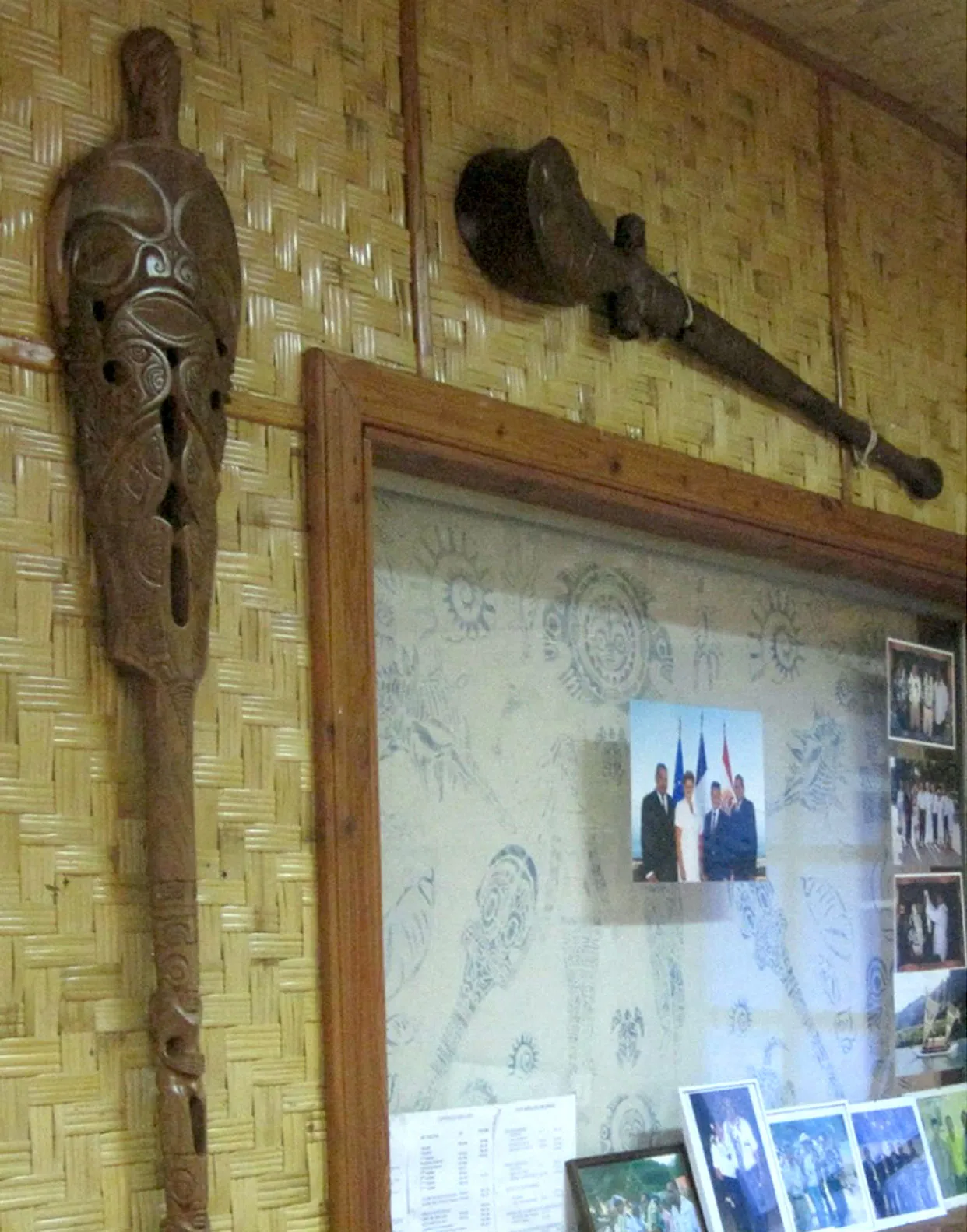
Marquesan war clubs on display in the office of Nuku Hiva’s mayor, ca. 2013. (Image credit: Emily C. Donaldson, 2013)
Still, contemporary Marquesan relationships to ùu are complex. As symbols of violence, the clubs can evoke centuries of colonial stereotyping and historic portrayals of Marquesans as “savage” and “cannibal.” But they also help Marquesans to make a living, assert their unique identity, connect with ancestral spiritual power (mana), and reclaim a symbol whose influence stretches back generations. Contemporary artists who paint, carve, and tattoo traditional designs treat old motifs as a gift from their ancestors, approaching them with a special respect. Being aware of this complexity and the mana that hides in certain Marquesan objects and designs is a crucial part of understanding Marquesan art.
Whether they were made for use or for sale, the ùu found throughout the world today speak to the violence and colonial trauma of the past. But they also remind us of Marquesan strength and resilience in facing those challenges. Now, as much as ever, the power of the Marquesan war club endures.
For more on these themes see Donaldson’s 2019 book, Working with the Ancestors: Mana and Place in the Marquesas Islands.
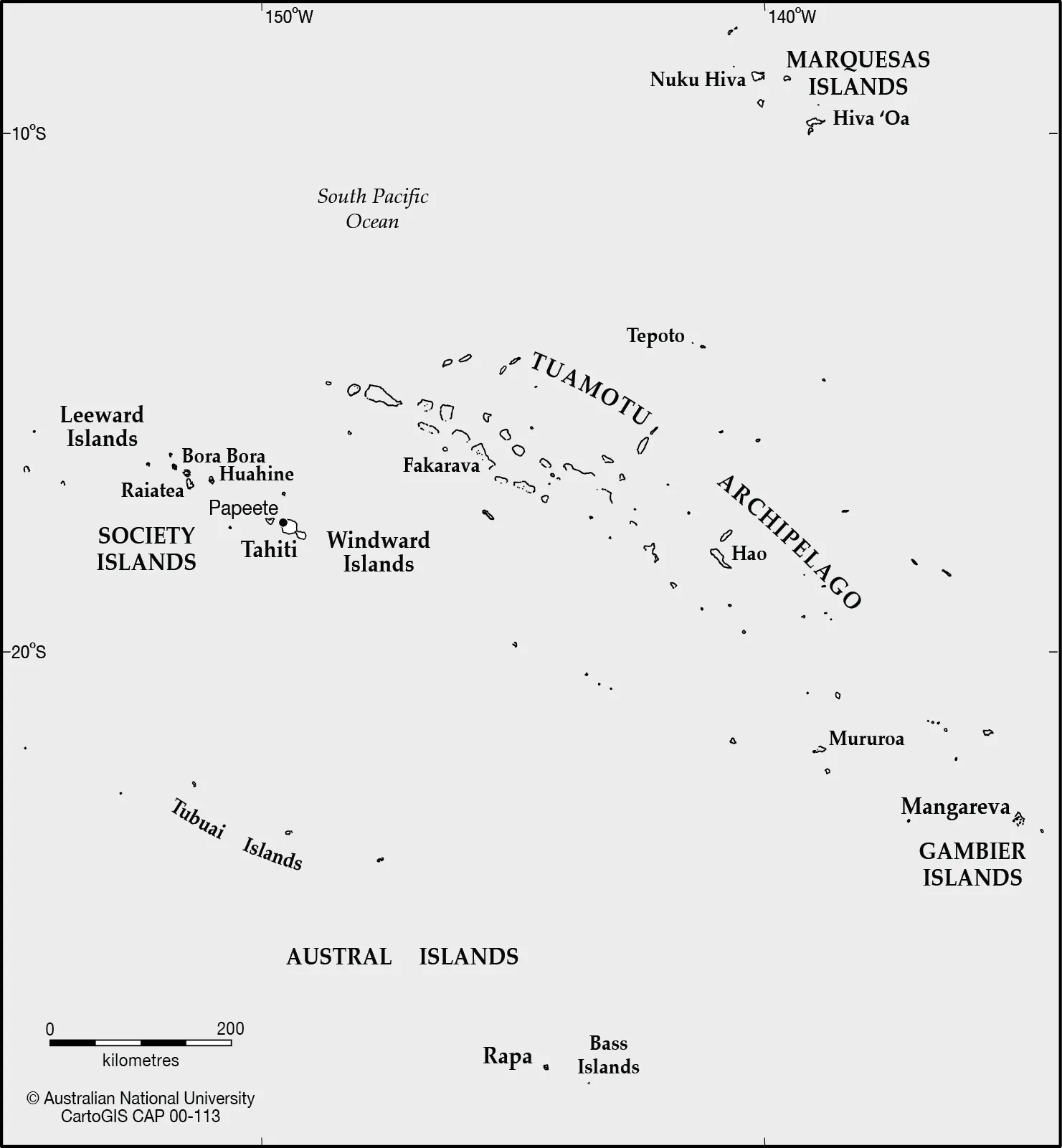
Map of French Polynesia, showing the Marquesas Islands at top right. (Map credit: Created by CartoGIS Services, College of Asia and the Pacific, The Australian National University.)


